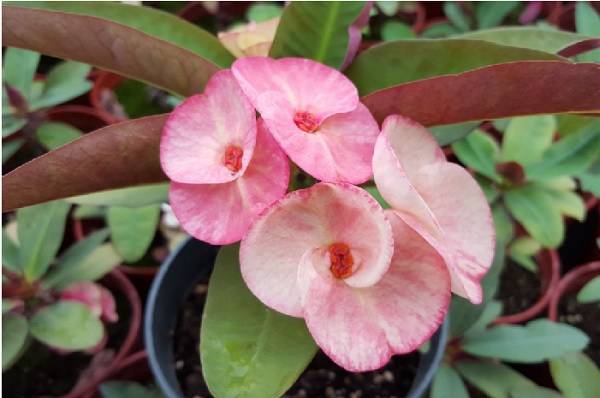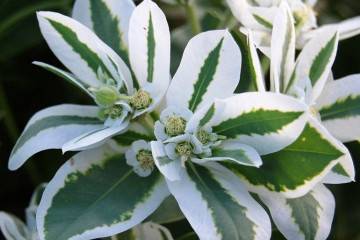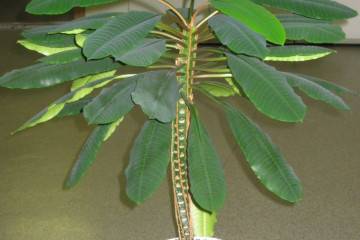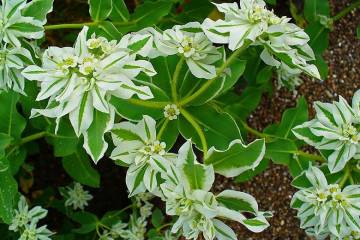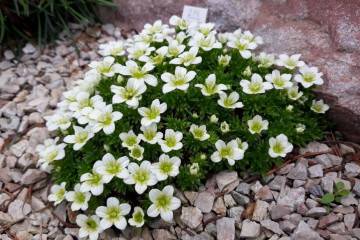Euphorbia flower Mila - how to care at home
Content:
Mille's milkweed is also called Milius's milkweed, or beautiful milkweed (and in Latin Euphorbia Milii). It is endemic to Madagascar and can be grown at home.
What does Euphorbia Mila look like?
Euphorbia Mila is a perennial plant. It is a relatively small shrub that belongs to the Euphorbia family.
In nature, euphorbia brilliant can grow up to 1.8 m in height. Its stem is covered with sharp and strong spines of dark purple color. The leaves reach a length of 5 cm and most often have a bright green tint. The inflorescences grow on long thin legs and resemble shields in appearance, they consist of bright leaves, most often of scarlet color, although other shades are also found. Which one to choose is a matter of taste for the grower himself. Bracts can be quite large, up to 10-12 mm wide.
Common varieties
There are several varieties of this type of milkweed. The most popular are:
- Sakura Kiss is a variety with an unusual color of inflorescences - with white bracts (contrary to popular belief, these are not petals), covered with pink veins;
- King Yellow is a cultivar with yellow flowers and hiding leaves;
- Moonlight is a variety with orange flowers and bright yellow leaves;
- Natali is a variety of milkweed with pink bracts covered with darker stripes;
- Sonora is the variety with the brightest pink bracts.
Despite the external differences, all of the listed varieties of Milius milkweed need approximately the same care.
Healing properties
Care must be taken with the flower. It not only has no medicinal properties, but is also poisonous (at least its juice). Therefore, for the plant, you need to find a place where children cannot reach it.
Briefly about the history of appearance
This plant is found in the wild only in Madagascar. It got to Europe thanks to the French ruler of the island of Reunion Pierre Bernard Milius. It was he who brought the first specimens of the flower to France in 1820. In honor of him, the euphorbia received the official name.
Features of caring for a plant at home
Breeding this plant in indoor conditions does not present any particular difficulties. Even a novice florist can cope with this task. Ideal conditions for indoor milkweed are cool rooms facing south. In winter, this plant can be kept in the room, but in the summer it is better to move it to fresh air.
Temperature
In nature, Mila spurge grows in Madagascar, so it is not surprising that it is considered a thermophilic plant. But he does not need too high a temperature either. In summer, it should be no more than 25 ° С, in winter - not lower than 15 ° С. Cold can severely harm euphorbia.
Lighting
Euphorbia is a light-loving plant.It is best that it receives enough light all year round, even in winter.
Watering
In nature, euphorbia brilliant also withstands desert conditions. But at home it is better for him to ensure regular watering. In the summer, it should be done at least once a week. In extreme heat, this can be done even more often.
Humidity
This plant prefers moderate air humidity, but in spring and during dry summers it can be slightly increased.
Priming
This flower has no special soil requirements. But since it belongs to the number of succulents, you can use store soil for these crops.
Top dressing
Many people think that looking after a flower means by all means applying fertilizers. In principle, euphorbia feels good even without it. But you can also feed, but only during the period of vegetative growth, and not more often than once a month. Succulent fertilizers are suitable for this task.
Features of care in winter, dormant period
In winter, the bush needs a lot of light, while you can keep it at room temperature. But it is advisable to place the pot with the plant so that the soil has a sufficiently high temperature (for example, you can find a place near a heater).
Answering the question why the spurge does not bloom at home, many growers mention the lack of nutrients. But in fact, the problem may be a lack of light. Yellowing of the leaves is associated with this, but their dropping is due to the fact that the water and temperature regimes are not observed.
When and how it blooms
At home, Mila's spurge can bloom constantly throughout the year, for which many growers love it.
As already noted, euphorbia can bloom at any time of the year and almost constantly, you just need to follow the rules of care. You can make the flowering more lush by lowering the temperature to winter level and arranging bright artificial lighting.
Pruning
If the side shoots grow strongly, the plant stops blooming. So it is worth trimming the euphorbia for the sake of more lush flowering. In addition, when thickening, the bush may lose foliage. In this case, elongated shoots should be shortened so that they do not interfere with the development of new ones. It is recommended to form the crown of the bush in the spring.
Transfer
It is better not to replant a young bush. You need to give it the opportunity to grow. Adult bushes are transplanted in the spring, every three years. This is mainly done when the roots no longer fit in the old pot. In this case, a more solid container is prepared for it, they take clay-sod soil with the addition of humus, transplant it like ordinary houseplants with an indispensable check of the roots and pruning of damaged areas.
How euphorbia Mila reproduces
As a rule, this variety is not propagated by seeds, but by cuttings. This method is considered the most versatile.
Germinating seeds
Theoretically, Mila's spurge can also propagate by seeds, and in this case they will be germinated in the usual way, that is, by planting them in small containers and arranging something like a mini-greenhouse. However, it is actually quite difficult to collect seeds at home. In addition, this method of reproduction does not allow preserving their varietal qualities. So it's better to give it up after all.
Rooting cuttings
The best way to propagate this type of euphorbia is by using cuttings. They allow you to get flowers of the same shade as on the parent bush. For this method, cuttings are taken from the tops. They are placed in the same mixture of peat and sand as when transplanting plants.
In order for the cuttings to take root faster, containers with seedlings are placed near the battery in order to better maintain the temperature of the soil. You can cover the containers with foil in the same way as when breeding with seeds to make a greenhouse.
Possible growing problems and diseases
Although Mila's milkweed needs minimal care at home, sometimes certain difficulties may arise.
- Drops buds and leaves. If the plant sheds leaves, then it does not have enough light, you just need to find a more suitable place for it.
- The leaves turn pale. The reasons for this phenomenon also lie in improper care, that is, a lack of light. The solution will be the same.
- The tips of the leaves dry. This happens when pests appear, the methods of dealing with which will be discussed below.
- The lower leaves fall off. This could be due to improper watering, in which the roots begin to rot. The affected areas must be removed, and the water regime must be corrected.
- Pests. Although it is a poisonous plant, it is not very insect resistant. The most common problems are infestation by aphids, scale insects, thrips and other houseplant pests.
If any insects appear, you need to spray the plant with insecticides. Actellik, fufan, intavir have proven themselves well.
It so happens that a plant slows down its growth, its leaves turn yellow and quickly die off, but there are no pests on their surface. In this case, it may be the result of the vital activity of the root mealybug. To check for its presence, the plant will have to be removed from the pot. Then on its root it will be possible to see mealy accumulations. In this case, you will have to clean the roots from this manually, remove the remnants of the earth from them and rinse in an insecticide solution. The pot must also be disinfected.
Thus, Euphorbia Mila is a flower that is not for everybody's taste. Not everyone is attracted to the thorns and small flowers on its bushes. In any case, this representative of the flora does not require special care, therefore, it is quite suitable for a variety of flower collection.

